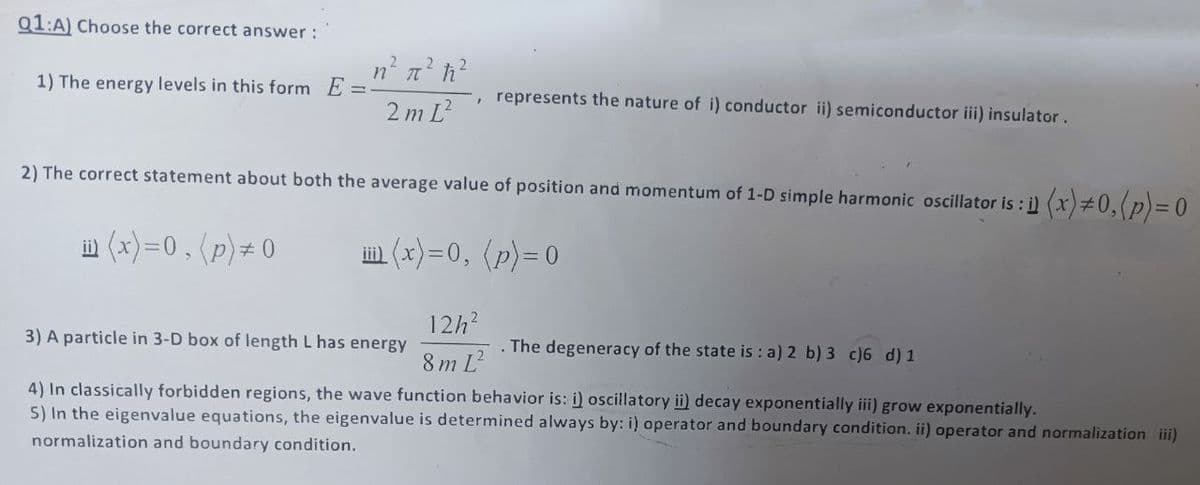Q1:A) Choose the correct answer : n² π² ħ² 1) The energy levels in this form E=- represents the nature of i) conductor ii) semiconductor iii) insulator. " 2m [² 2) The correct statement about both the average value of position and momentum of 1-D simple harmonic oscillator is : i) (x) #0, (p) = 0 (x)=0, (p)*0 (x)=0, (p)=0 12h² 3) A particle in 3-D box of length L has energy . The degeneracy of the state is: a) 2 b) 3 c)6 d) 1 8mi
Q1:A) Choose the correct answer : n² π² ħ² 1) The energy levels in this form E=- represents the nature of i) conductor ii) semiconductor iii) insulator. " 2m [² 2) The correct statement about both the average value of position and momentum of 1-D simple harmonic oscillator is : i) (x) #0, (p) = 0 (x)=0, (p)*0 (x)=0, (p)=0 12h² 3) A particle in 3-D box of length L has energy . The degeneracy of the state is: a) 2 b) 3 c)6 d) 1 8mi
Modern Physics
3rd Edition
ISBN:9781111794378
Author:Raymond A. Serway, Clement J. Moses, Curt A. Moyer
Publisher:Raymond A. Serway, Clement J. Moses, Curt A. Moyer
Chapter6: Quantum Mechanics In One Dimension
Section: Chapter Questions
Problem 15P
Related questions
Question

Transcribed Image Text:Q1:A) Choose the correct answer :
n² π² ħ₁²
1) The energy levels in this form E=
represents the nature of i) conductor ii) semiconductor iii) insulator.
"
2mL²
2) The correct statement about both the average value of position and momentum of 1-D simple harmonic oscillator is : i) (x) #0, (p) = 0
ii (x)=0, (p) # 0
iii(x)=0, (p) = 0
3) A particle in 3-D box of length L has energy
12h²
8mL
The degeneracy of the state is : a) 2 b) 3 c)6 d) 1
4) In classically forbidden regions, the wave function behavior is: i) oscillatory ii) decay exponentially iii) grow exponentially.
5) In the eigenvalue equations, the eigenvalue is determined always by: i) operator and boundary condition. ii) operator and normalization
normalization and boundary condition.
Expert Solution
This question has been solved!
Explore an expertly crafted, step-by-step solution for a thorough understanding of key concepts.
Step by step
Solved in 2 steps

Knowledge Booster
Learn more about
Need a deep-dive on the concept behind this application? Look no further. Learn more about this topic, physics and related others by exploring similar questions and additional content below.Recommended textbooks for you

Modern Physics
Physics
ISBN:
9781111794378
Author:
Raymond A. Serway, Clement J. Moses, Curt A. Moyer
Publisher:
Cengage Learning

Physics for Scientists and Engineers with Modern …
Physics
ISBN:
9781337553292
Author:
Raymond A. Serway, John W. Jewett
Publisher:
Cengage Learning

Principles of Physics: A Calculus-Based Text
Physics
ISBN:
9781133104261
Author:
Raymond A. Serway, John W. Jewett
Publisher:
Cengage Learning

Modern Physics
Physics
ISBN:
9781111794378
Author:
Raymond A. Serway, Clement J. Moses, Curt A. Moyer
Publisher:
Cengage Learning

Physics for Scientists and Engineers with Modern …
Physics
ISBN:
9781337553292
Author:
Raymond A. Serway, John W. Jewett
Publisher:
Cengage Learning

Principles of Physics: A Calculus-Based Text
Physics
ISBN:
9781133104261
Author:
Raymond A. Serway, John W. Jewett
Publisher:
Cengage Learning

College Physics
Physics
ISBN:
9781938168000
Author:
Paul Peter Urone, Roger Hinrichs
Publisher:
OpenStax College

University Physics Volume 3
Physics
ISBN:
9781938168185
Author:
William Moebs, Jeff Sanny
Publisher:
OpenStax